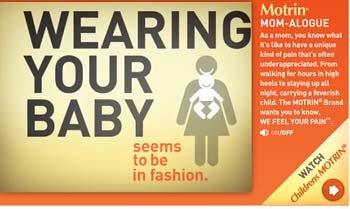 A few ways the predominantly negative publicity about this Motrin ad was spread online were from blog posts, YouTube video responses, and probably most importantly Twitter. Twitter is a social networking site that allows users to constantly update their statuses for friends to read and interact with. This site had a profound impact by instantly spreading the word about Motrin's ad to other users. Motrin quickly became one of the most searched topics on the entire Twitter site and the medicine's mistake was gaining interest on the blogosphere as writers were updating posts according to developments with the response to the ad. This is a grand example of what advertisers try to avoid when releasing new campaigns and these types of negative feedback are usually gained early on in testing the ads before release. It seems that a simple lack of care by Motrin and/or their advertising agency to put out this controversial ad without testing it for feedback. This lesson however, will prove as a prime example of why it is necessary to not only properly test ads before release but also how to closely monitor the follow-up and reactions given off by the target audience. If Motrin had kept a closer eye on the initial feedback the ad was producing, this story, which has been picked up by just about every advertising blog I could find, would have blown over as a small mistake. Instead, the company has been forced to take on a large public relations effort to control any damage that was done to their image. The task at hand is not yet over for Motrin despite having taken a few of the necessary steps since the video's release, but I have explored the blogosphere to read a few posts and comment on them with my own insight on the story. The first post I commented on is from Shankman.com by Peter Shankman, on his post "The REAL problem with the Motrin ads..." And the other blog I wrote a comment on, was the What'sNextBlog.com by B.L. Olchman in a post titled "Social Media Storm Spreads as Motrin Ad Angers Moms."
A few ways the predominantly negative publicity about this Motrin ad was spread online were from blog posts, YouTube video responses, and probably most importantly Twitter. Twitter is a social networking site that allows users to constantly update their statuses for friends to read and interact with. This site had a profound impact by instantly spreading the word about Motrin's ad to other users. Motrin quickly became one of the most searched topics on the entire Twitter site and the medicine's mistake was gaining interest on the blogosphere as writers were updating posts according to developments with the response to the ad. This is a grand example of what advertisers try to avoid when releasing new campaigns and these types of negative feedback are usually gained early on in testing the ads before release. It seems that a simple lack of care by Motrin and/or their advertising agency to put out this controversial ad without testing it for feedback. This lesson however, will prove as a prime example of why it is necessary to not only properly test ads before release but also how to closely monitor the follow-up and reactions given off by the target audience. If Motrin had kept a closer eye on the initial feedback the ad was producing, this story, which has been picked up by just about every advertising blog I could find, would have blown over as a small mistake. Instead, the company has been forced to take on a large public relations effort to control any damage that was done to their image. The task at hand is not yet over for Motrin despite having taken a few of the necessary steps since the video's release, but I have explored the blogosphere to read a few posts and comment on them with my own insight on the story. The first post I commented on is from Shankman.com by Peter Shankman, on his post "The REAL problem with the Motrin ads..." And the other blog I wrote a comment on, was the What'sNextBlog.com by B.L. Olchman in a post titled "Social Media Storm Spreads as Motrin Ad Angers Moms.""The REAL problem with Motrin ads..."
Comment:
Peter, thank you for writing an informative and useful post to your expanding blog. This story has recently gained ample attention across the Internet, most importantly on Twitter and blog sites. I enjoyed reading your stance on the situation and also your tips in aiding others to not make the same mistake were very relevant and practical. You were wise in your writing to maintain an inoffensive stance on the situation while providing your own input into the story. Much of your opinion is backed by current trends and is also reflective of some of my own points. I agree with your argument about "Mommy-Bloggers" and that they truly are influential, not only due to their frequency of posting, but also due to the community aspect they feel and relate to online.
 Also your idea about using a mother in a position of power is a great point as this seems like an act of utter disregard by the company or agency to acknowledge a now-common technique practiced in marketing, gaining constant insight from the audience themselves. Could this just have been a campaign by Motrin that came about with all "gut feeling" and no substantial evidence to support it? It sure seems that way judging from the negativity that has sparked all of this. But then again, how could a company under a division of Johnson & Johnson make such a large mistake with their target audience?
Also your idea about using a mother in a position of power is a great point as this seems like an act of utter disregard by the company or agency to acknowledge a now-common technique practiced in marketing, gaining constant insight from the audience themselves. Could this just have been a campaign by Motrin that came about with all "gut feeling" and no substantial evidence to support it? It sure seems that way judging from the negativity that has sparked all of this. But then again, how could a company under a division of Johnson & Johnson make such a large mistake with their target audience?AdAge's story on the topic does bring about a topic worthy of noting, that the online ad has been out for a few weeks now and it has not been controversial until now. Perhaps this is because some powerful social networkers have recently picked up the problematic story to spread to others. It already seems that issues like this arise all of the time, stemming from the fact that those with influence, like widely read bloggers, are able to dictate what their readers see or hear. It is interesting to ponder how many ads could potentially fall victim the same way as this Motrin ad if they were all to be discussed so widely. Thank you for this insightful and educational post and I look forward to reading more of your scholarly advice in the future.
"Social Media Storm Spreads as Motrin Ad Angers Moms"
Comment:
Thank you for your timely and intuitive post on this developing story. I appreciate your consistent updates to keep your readers informed as the issue at hand progresses. I applaud you on your assessment of the story and the feedback you then provide of how to handle the situation from the brand's side. Your advice to Motrin of what they should do is practical and useful and seems like the most logical steps that the brand should take in order to repair any damage that was done. I particularly enjoyed your fourth tip to "Spend money creating a socially responsible program that helps real mothers with a real issue - preferably one they vote on." This appears to be the best step that Motrin can take to move on from this while still acknowledging the fact they made a mistake in a way that spins the issue from negative to positive in one fell swoop. I believe this is a practice other brands have used in the past to advance from prior mistakes similar to this one.
I was amused by your remarks about brands and their use of marketing efforts on the weekends as, just like you said, the Internet is a 24/7 thing that most brands often do not keep track fully of. Things happen instantly online and I agree that brands should keep a never-ending watch to how their brand is perceived and written about online. With the future of branding at stake, does this vivid example of what not to do set a standard for other Internet efforts? This surely seems like a widespread point of learning for other brands but with the consistent pace and ever evolving form of the Internet, will brands ever be safe to make a mistake again? The room for mistakes is constantly narrowing down until we may see the loss of any risk-taking efforts.
Your blog posts are continually of the highest caliber and I am glad you covered this topic with such detail and opinion. Thank you for your post and I look forward to gaining some feedback from you on this subject matter.













